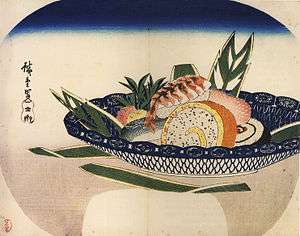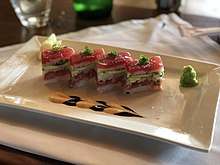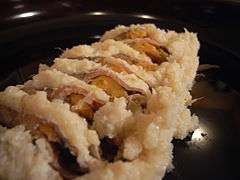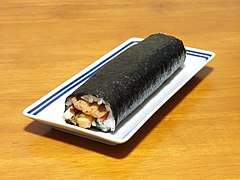History of sushi
The history of sushi began with paddy fields in Southeast Asia, where fish was fermented with rice vinegar, salt and rice, after which the rice was discarded. The dish is today known as narezushi, and was introduced to Japan around the Yayoi period.[1] In the Muromachi period, people began to eat the rice as well as the fish.[2] During the Edo period, vinegar rather than fermented rice began to be used. In pre-modern times and modern times, it has become a form of food strongly associated with Japanese culture.[3]

Early history
The earliest form of sushi, a dish today known as narezushi, has its probable origin with paddy fields along the Mekong river in Southeast Asia. The prototypical narezushi is made by lacto-fermenting fish with salt and rice in order to control putrefaction.[1] Spreading southwards down the Mekong, narezushi then entered Austronesia. In Japan the dish's distribution overlaps with the introduction of wet-field rice cultivation during the Yayoi period.[1][4]
Narezushi appears in the Chinese dictionary in the 2nd century CE as the character sa (鮓, pickled fish with salt and rice),[5] which was during a period in which the Han Chinese were expanding south of the Yangtze river, adopting the food from the non-Han peoples.[1]
The Japanese preferred to eat fish with rice, known as namanare or namanari (生成, なまなれ, なまなり, semi-fermented). During the Muromachi period namanare was the most popular type of sushi. Namanare was partly raw fish wrapped in rice, consumed fresh, before it changed flavor. This new way of consuming fish was no longer a form of preservation but rather a new dish in Japanese cuisine.
During the Edo period, a third type of sushi was developed, haya-zushi (早寿司, 早ずし, fast sushi). Haya-zushi was assembled so that both rice and fish could be consumed at the same time, and the dish became unique to Japanese culture. It was the first time that rice was not being used for fermentation. Rice was now mixed with vinegar, with fish, vegetables and dried food stuff added. This type of sushi is still very popular today. Each region utilizes local flavors to produce a variety of sushi that has been passed down for many generations.
Today's style of nigirizushi (握り寿司), consisting of an oblong mound of rice with a slice of fish draped over it, became popular in Edo (contemporary Tokyo) in the 1820s or 1830s. One common story of nigirizushi's origins is of the chef Hanaya Yohei (1799–1858), who invented or perfected the technique in 1824 at his shop in Ryōgoku.[6] After the Great Kanto earthquake in 1923, nigirizushi chefs were displaced from Edo throughout Japan, popularizing the dish throughout the country.
Sushi in Japan
The earliest reference to sushi in Japan appeared in 718 in the Yōrō Code (養老律令 Yōrō-ritsuryō). As an example of tax paid by actual items, it is written down as "雑鮨五斗 (about 64 liters of zakonosushi or zatsunosushi?)". However, there is no way to know what this "sushi" was or even how it was pronounced. By the 9th and 10th century "鮨" and "鮓" are read as "sushi". This "sushi" was similar to today's narezushi.
For almost the next 800 years, until the early 19th century, sushi slowly changed and the Japanese cuisine changed as well. The Japanese started eating three meals a day, rice was boiled instead of steamed, and of large importance, was the development of rice vinegar.[7] While sushi continued to be produced by fermentation of fish with rice, the addition of rice vinegar greatly reduced the time of fermentation[8] and the rice used began to be eaten along with the fish. In the Muromochi Period (1336 to 1573), the process of producing oshizushi was gradually developed where in the fermentation process the use of salt was abandoned and vinegar was used instead. In the Azuchi-Momoyama period (1573–1603), namanare was invented. A 1603 Japanese-Portuguese dictionary has an entry for namanrina sushi, literally half-made sushi. The namanare was fermented for a shorter period than the narezushi and possibly marinated with rice vinegar. It still had the distinctive smell of narezushi.

The smell of narezushi was likely one of the reasons for shortening and eventually skipping the fermentation process. It is commonly described as "a cross between blue cheese, fish, and rice vinegar".[8] A story from Konjaku Monogatarishū written in early 12th century makes it clear that it was not an attractive smell, even if it tasted good: In the early 18th century, oshizushi was perfected in Osaka and it came to Edo by the middle of 18th century. These sushi were sold to customers, but because they still required a little fermentation time, stores hung a notice and posters to customers on when to come for a sushi. Sushi was also sold near a park during a hanami period and a theater as a type of Bento. Inarizushi was sold along oshizushi. Makizushi and chirashizushi also became popular in Edo period.
There were three famous sushi restaurants in Edo, Matsunozushi (松之鮨), Yoheizushi (興兵衛鮓), and Kenukizushi (けぬき寿し) but there were thousands more sushi restaurants. They were established in a span of barely twenty years at the start of the 19th century. Nigirizushi was an instant hit and it spread through Edo like wildfire. In the book Morisadamanko (守貞謾稿) published in 1852, the author writes that for a cho (100 meters by 100 meters or 10,000 square meters) section of Edo there were one or two sushi restaurants, but that only one soba restaurant could be found in 1 or 2 cho. This means that there were nearly 2 sushi restaurants for every soba restaurant.
These early nigirizushi were not identical to today's varieties. Fish meat was marinated in soy sauce or vinegar or heavily salted so there was no need to dip into soy sauce. Some fish was cooked before it was put onto a sushi. This was partly out of necessity as there were no refrigerators. Each piece was also larger, almost the size of two pieces of today's sushi.
The advent of modern refrigeration allowed sushi made of raw fish to reach more consumers than ever before. The late 20th century saw sushi gaining in popularity all over the world.
Funazushi

Funazushi is a rare type of narezushi prepared near Lake Biwa, Shiga Prefecture.[9] Eighteen generations of the Kitamura family have been preparing the dish at Kitashina since 1619.[10]
Fresh funa are scaled and gutted through their gills keeping the body (and always the roe) of the fish intact. The fish are then packed with salt and aged for a year before being repacked annually in fermented rice for up to four years. The resulting fermented dish may be served sliced thin or used as an ingredient in other dishes.[11]
Authentic funazushi is made from a wild subspecies of goldfish called nigorobuna (a wild type of Carassius auratus) endemic to the lake. It is actually technically misleading to say that "crucian carp" is used, as though any funa type carp in the genus may be substituted, especially since the true crucian carp is a distinct species altogether, C. carassius, and is not indigenous to Lake Biwa.[12] However, due to reduced catch of nigorobuna in recent years, it is true that, by necessity, certain other native species are starting to be substituted.
Makizushi

After the invention of the sheet form of nori seaweed around 1750, makizushi or norimaki, rice and various ingredients rolled with nori appeared.[13][14] The term makizushi was first used in a book Ryōri Sankaikyō (料理山海郷, 1749). However this dish is not current day makizushi but seafood rolled with bamboo mat (makisu).[15][16][17] Current day makizushi first appeared in a book Shinsen Kondate buruishū (新撰献立部類集, 1776) which describes makizushi as "Place a sheet of asakusa-nori, pufferfish or paper on the makisu and spread the cooked rice then arrange fishes on it. Roll the makisu tightly from one side ..."[13][15][16][18] In 1778, a food shop guide book Shichijyūgonichi (七十五日, 1778) listed a shop whose famous menu is "norimaki-zushi".[13] A later book Meihan Burui (名飯部類, 1802) describes makizushi as "Spread asakusa-nori on the board, place the sushi rice on it. Ingredients are sea bream, abalone, shiitake, mitsuba and shiso. Roll them firmly...."[14][16][19]
Sushi and Western culture
The Oxford English Dictionary notes the earliest written mention of sushi in an 1893 book, Japanese Interiors, where it mentions that "Domestics served us with tea and sushi or rice sandwiches".[20][21] However, there is also mention of sushi in a Japanese-English dictionary from 1873,[22] and an 1879 article on Japanese cookery in the journal Notes and Queries.[23] Additionally, the 1879 best-selling book A Tour Around the World by General Grant by James Dabney McCabe describes former president Ulysses S. Grant dining on the "shashimi" [sic] version of sushi during his visit to Japan.[24]
United States

Sushi was already being served in the United States by the early 1900s, following an influx of Japanese immigration after the Meiji Restoration.[24] The first sushi shop in the U.S. reportedly opened in 1906 in the Little Tokyo neighborhood of Los Angeles.[25] H.D. Miller, food historian of Lipscomb University has written that a wave of Japanophilia in American high society resulted in the serving of sushi at social functions. Popularity of Japanese food peaked ca. 1905 when it was being served at Japanese-themed social gatherings across the United States, including in mid-western cities such as Minneapolis, Minnesota, St. Louis, Missouri and Bismarck, North Dakota.[24] According to Miller, the earliest published mention of sushi eaten by an American, in America, was an 18 August 1904 article in the Los Angeles Herald about a luncheon served in Santa Monica by the socialite Fern Dell Higgins.[24]
Several years later, a wave of anti-Japanese nativism sentiments and restrictions on Japanese immigration, starting with the Gentlemen's Agreement of 1907, caused a subsequent decline in the acceptance of Japanese cuisine.[24] After the outbreak of World War II, Japanese-American restaurants on the West Coast were generally forced to close and sell off their businesses due to internment orders on their proprietors.[26] One restaurant that reopened after the war to serve sushi was Matsuno Sushi (Matsu-no-sushi) in Little Tokyo, Los Angeles. This restaurant had been in business at least since 1938 or 1939,[27][28] and by 1949, it was back serving sushi (featuring local bluefin tuna[29]) for lunch. But the maki and inari they served was not shaped by hand by trained chefs, but molded in cookie-cutters.[30]
The Kawafuku restaurant in Little Tokyo has been credited with being the "first true sushi bar" in the United States,[31] that is to say, the first to serve sushi from a trained sushi chef in the country.[32][33] Some sources accept the claim made by a man named Noritoshi Kanai that he was the person instrumental in persuading Kawafuku's owner to start the sushi section. Kanai has also claimed to be the person who coined the term "sushi bar". Kanai headed the Tokyo-based arm of Mutual Trading, an importer of Japanese food ingredients that served Kawafuku and other restaurants.[34][33] The first sushi chef in America according to this account was Shigeo Saito, and some sources paint the chef as the principal figure who brought real sushi to the U.S.[31]
Though the true origin is disputed, many believe the California roll was invented in Los Angeles by substituting a slice of avocado for the seasonal toro (fatty tuna) in a traditional maki roll.[35]
United Kingdom
A report of sushi being consumed in Britain occurred when the then Crown Prince Akihito (born 1933) visited Queen Elizabeth II at the time of her Coronation in May 1953.[36][37]
Canada
Although sushi was first served in Canada with the first arrivals of Japanese immigrants during the 19th century, it was not until changes to immigration rules in the 1960s that it started becoming widely available.[38] Vancouver in particular went from 3 sushi outlets in 1976 to more than 600 in 2014, a larger number per capita than in Canada's largest city Toronto.[39] Although the true origin is disputed, it's widely believed that Chef Hidekazu invented the California roll (originally called "Tojo-maki") in Vancouver, by inverting the roll and putting rice on the outside to make it more accessible to Western tastes, and adding non-traditional ingredients like avocado.[40] The B.C. roll was also invented in Vancouver by Hidekazu in 1974 using barbecued salmon.
Australia
Australia is a major source of rice used in sushi, in particular Leeton, New South Wales, which is the headquarters of SunRice.[41][42]
Sushi is believed to have been introduced into Australia between the early 1970s[43] and the 1980s.[44] The first known sushi conveyor belt in Australia appeared in Queensland in 1993, when Sushi Train opened its first restaurant.[45]
New Zealand
When David Bowie played in Auckland in 1983 as part of the Serious Moonlight Tour, it was rumoured his contract rider stated that sushi be on the menu, which at the time was rare and exotic in New Zealand,[46] and typically served only in high-end city restaurants.[47]
St Pierre's, a nationwide food franchise, officially began serving sushi in 1993[48], after originally being established as a seafood delicatessen in the 1980s.[49]
Etymology
The Japanese name "sushi" is written with kanji (Chinese characters) for ancient Chinese dishes which bear little resemblance to today's sushi.
One of these might have been a salt pickled fish. The first use of "鮨" appeared in the face and hand, the oldest Chinese dictionary believed to be written around the 3rd century BC. It is explained as literally "Those made with fish (are called) 鮨, those made with meat (are called) 醢". "醢" is a fermented meat made from salt and minced pork and "鮨" is a fermented fish made from salt and minced fish. The Chinese character "鮨" is believed to have a much earlier origin, but this is the earliest recorded instance of that character being associated with food. "鮨" was not associated with rice.
In 2nd century AD, another character used to write "sushi", "鮓", appeared in another Chinese dictionary of Han dynasty: "鮓滓也 以塩米醸之加葅 熟而食之也", which translates as "鮓 is a food where fish is pickled by rice and salt, and itself is eaten when cooked" ("cooked" here referring to preparing food by denaturing proteins with acid rather than heat, similar to the preparation of ceviche). This food is believed to be similar to narezushi, i.e. that the fish was fermented for long times in conjunction with rice and was then eaten after removing the rice.
A century later, the meaning of the two characters had become confused and by the time these two characters arrived in Japan, the Chinese themselves did not distinguish between them. The Chinese had stopped using rice as a part of the fermentation process, and then stopped eating pickled fish altogether. By the Ming dynasty, "鮨" and "鮓" had disappeared from Chinese cuisine.
See also
References
- Citations
- Lee, Cherl-Ho; Steinkraus, Keith H.; Reilly, P. J. Alan. Fish Fermentation Technology. pp. 15–16. ISBN 9788970530031.
- Barakan, Peter. "Japanology Plus Sushi". NHK World. Retrieved 5 April 2017.
- Barakan, Peter. "Begin Japanology". NHK World. Retrieved 5 April 2017.
- Hiroto Takamiya (2001). "Introductory Routes of Rice to Japan: An Examination of the Southern Route Hypothesis" (PDF). Asian Perspectives. University of Hawaii Press. 40 (2): 209–226. doi:10.1353/asi.2001.0026.
- "The complete history of sushi". Business Insider. 9 February 2015. Retrieved 1 August 2017.
- Bestor, Theodore C. (13 July 2004). Tsukiji: The Fish Market at the Center of the World. p. 141. ISBN 9780520923584.
- Mpritzen, Ole G. (2009). Sushi: Food for the Eye, the Body and the Soul. Springer Science-Business Media. p. 15.
- Hsin-I Feng, C. (2012), The Tale of Sushi: History and Regulations. Comprehensive Reviews in Food Science and Food Safety, 11: 205–220. doi: 10.1111/j.1541-4337.2011.00180.x
- "The Kyoto Project: Funazushi". Kyoto University of Foreign Studies. 2 September 2013. Archived from the original on 6 July 2015. Retrieved 6 July 2015.
- Atsushi Kitamura (9 December 2008). "Japan". Bizarre Foods with Andrew Zimmern. Season 2. Episode 13. Travel Channel.
- Hiroya Kawanabe; Machiko Nishino; Masayoshi Maehata (2012). Lake Biwa: Interactions between Nature and People. Springer Science & Business Media. p. 344. ISBN 978-94-007-1783-1. Retrieved 6 July 2015.
- Hosking, Richard (1998), Walker, Harlan (ed.), "From Lake and Sea Goldfish and Mantis Shrimp Sushi" (preview), Fish, Food from the Waters: Proceedings of the Oxford Symposium on Food and Cookery, Oxford Symposium Press, pp. 160–161, ISBN 978-0-907325-89-5, p.161
- Miyashita, Akira (2003). 海苔 [Nori]. Hosei University Press. ISBN 4588211110.
- Katada, Minoru (1989). 浅草海苔盛衰記 [Asakusa nori rise and fall]. Seizando-Shoten Publishing. ISBN 442582251X.
- Kawakami, Kōzō (2006). 日本料理事物起源 [Origin of Japanese cuisine]. Iwanami Shoten. ISBN 4000242407. Archived from the original on 26 January 2016.
- Ōkawa, Tomohiko (2008). 現代すし学 [Sushiology]. Asahiya Publishing. ISBN 978-4751107270.
- Ryōri Sankaikyō (料理山海郷). Enshudō (園趣堂). 1819. Reprint edition of 1749
- Nakagawa, Tōshirō (1776). Shinsen Kondate buruishū (新撰献立部類集).
- Sugino, Gonbei (1802). Meihan Burui(名飯部類).
- "Sushi", Oxford English Dictionary, Second edition, 1989; online version December 2011. Retrieved 23 December 2011.
- Alice Mabel Bacon, "A Japanese interior", Houghton, Mifflin and Company, 1893, p.. 180)
- James Curtis Hepburn, Japanese-English and English-Japanese dictionary, Publisher: Randolph, 1873, 536 pages (p. 262)
- W.H. Patterson, "Japanese Cookery", Notes and queries, Publisher: Oxford University Press, 1879. (p. 263)
- Miller, Howard D. (23 July 2015). "The Great Sushi Craze of 1905 The Unexpected History of Japanese Food in America, From Edo Bay to the Bowery". An Eccentric Culinary History. eccentricculinary.com. Retrieved 18 August 2015.
- Wank, David L.; Farrer, James (2015). "Chapter 5: Chinese Immigrants and Japanese Cuisine in the United States: a Case of Culinary Glocalization". The Globalization of Asian Cuisines. Springer.CS1 maint: ref=harv (link), citing Ishige, Naomichi; Koyama, Shuzou; Yamaguchi, Masatomo; Ekuan, Shouji (1985), ロスアンジェルスの日本料理店―その文化人類学的研究 (Rosuanjerusu no nihon ryōriten: sono bunka jinruigakuteki kenkyū) [Japanese restaurants in Los Angeles: an anthropological research] (in Japanese), Domesu Shuppan, pp. 28–33
- Smith (2012), p. 89.
- Interview of S. John Nitta in "Downtown: The Old Meets the New". Los Angeles Times. 10 October 1971.
- Listed in the 1939 directory: New World-sun Year Book 新世界朝日年鑑 (Shin-Sekai Asahi Nenkan), Los Angeles: New World Sun, 1939, p. 435 (misprinted as p. 535)
- Smith (2012), p. 93.
- Issenberg (2007), p. 80.
- Issenberg (2007), p. 88.
- Corson (2008), pp. 45–46.
- Al-Jamie, Anthony (15 May 2013). "The Man Who Brought Sushi to America". Tokyo Journal. Retrieved 30 March 2017.
- Smith (2012), p. 90.
- McInerney, Jay (10 June 2007). "Raw". The New York Times. Retrieved 15 August 2008. (book review of Corson 2007 and Issenberg 2007)
- 30 May 1953 "Japanese women eating sushi whilst they wait to catch a glimpse of Prince Akihito, in England as a coronation guest of the Queen", photographer John Chillingworth, Picture Post at Getty Images
- "Prince Akihito Eats and Runs at Own Soiree", Chicago Daily Tribune, 4 May 1953, page 22
- Gabby Peyton. "IT'S CANADIAN: THE HISTORY OF THE CALIFORNIA ROLL". Food Bloggers of Canada.
- Douglas Todd (4 May 2014). "Vancouver may be sushi capital of North America".
- Madeleine White (2012-10-23). "Meet the man behind the California roll". The Globe and Mail. Retrieved 2015-07-06.
- 2007 Kikkoman Food Culture Seminar – The Internationalization of Sushi
- Laurissa Smith (22 April 2014). "Sushi boom increases rice markets for Riverina growers". ABC.
- Hilary Neal (7 January 2006). "Is Aussie sushi fishy or real deal?". Japan Times.
- "The History of Sushi". Sushi Machine.
- Sushi Train – About us
- Russell Brown (12 January 2016). "Hard News: Bowie". Public Address.
- Livia Esterhazy (3 June 2018). "Blockchain: the new frontier in the battle against slavery for sushi". The Spinoff.
- Errol Kiong (11 November 2008). "Chicken sushi conquered Kiwi tastebuds". New Zealand Herald.
- St Pierres – About Us
- Bibliography
- Corson, Trevor (2007). The Zen of Fish: The Story of Sushi, from Samurai to Supermarket. HarperCollins. ISBN 978-0060883508.CS1 maint: ref=harv (link)
- Corson, Trevor (2008). The Story of Sushi: An Unlikely Saga of Raw Fish and Rice. Harper Perennial. ISBN 978-0060883515.CS1 maint: ref=harv (link)
- Issenberg, Sasha (2007). The Sushi Economy: Globalization and the Making of a Modern Delicacy. Penguin. ISBN 9781592402946.CS1 maint: ref=harv (link)
- Smith, Andrew F. (2012). 'American Tuna: The Rise and Fall of an Improbable Food. University of California Press. ISBN 9780520954151.CS1 maint: ref=harv (link)
External links
- History of Sushi
- Sushi Dictionary (寿司用語辞典; in Japanese)
- Sushi Q & A (すしのQ&A; in Japanese)
- The History of Sushi.
